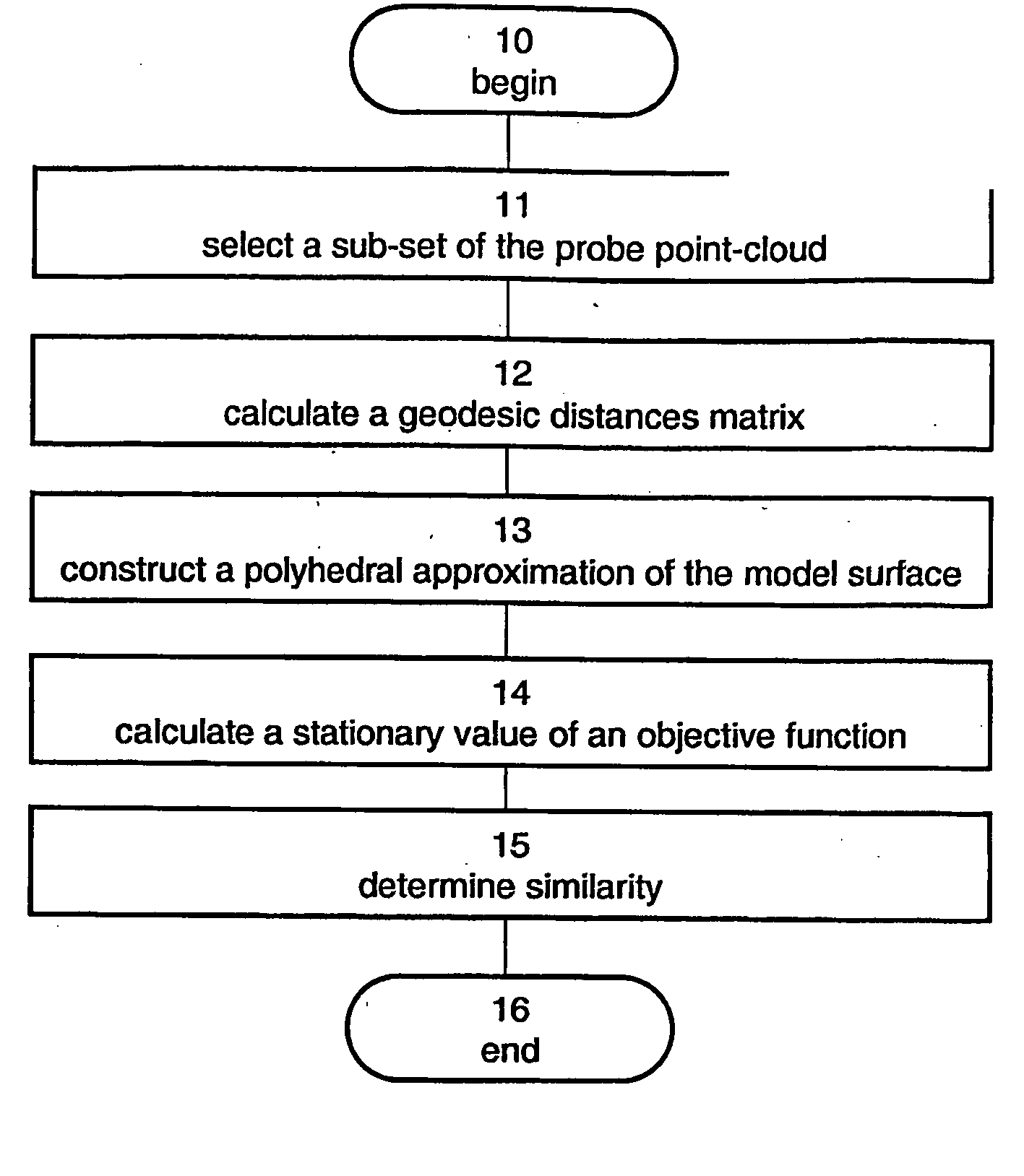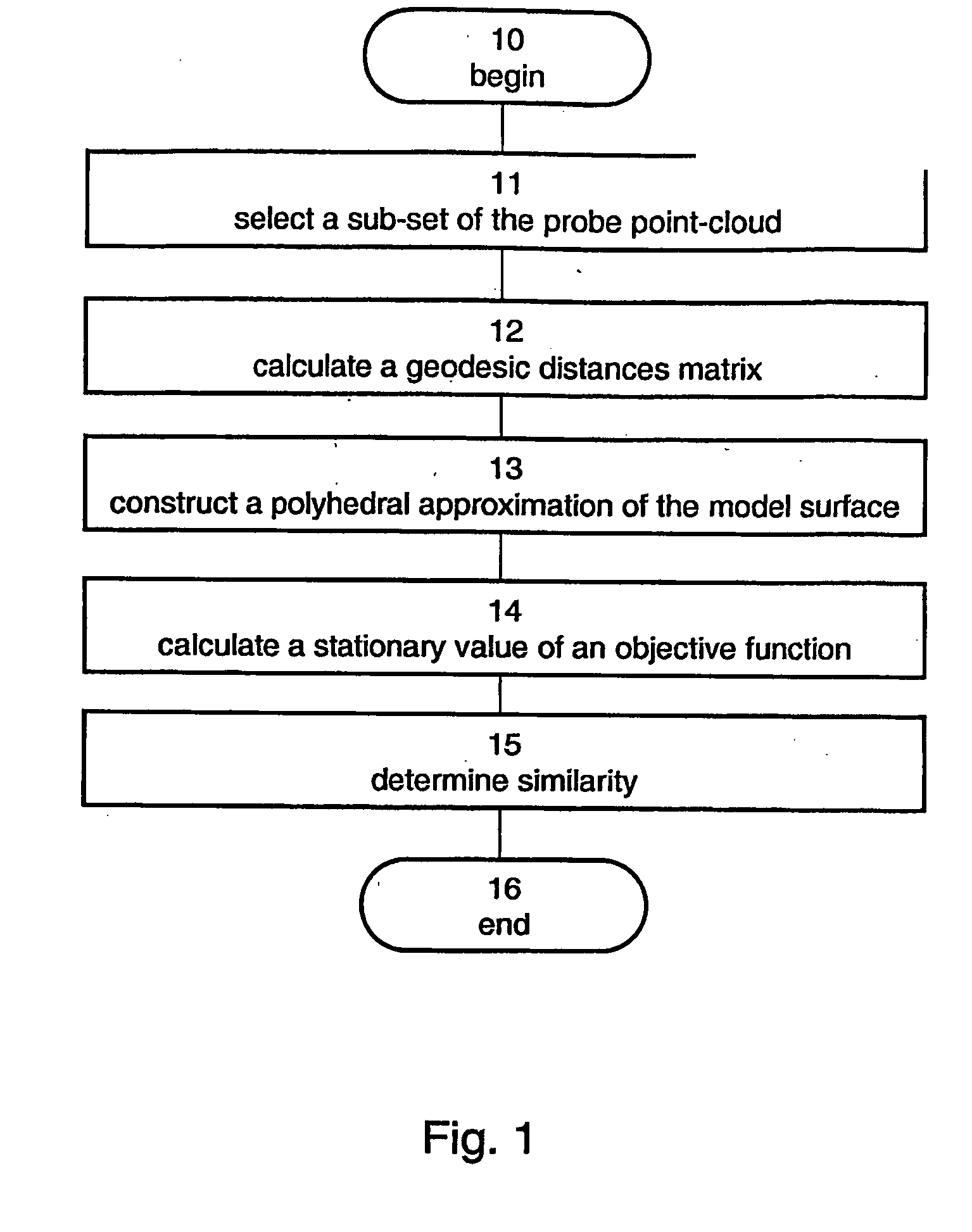Method And Apparatus For Determining Similarity Between Surfaces
a surface similarity and surface technology, applied in the field of automatic object recognition, can solve the problems of lack of appropriate image acquisition means, hampered multiple attempts in the past, and suffers from sensitivity to illumination conditions and object orientation,
- Summary
- Abstract
- Description
- Claims
- Application Information
AI Technical Summary
Benefits of technology
Problems solved by technology
Method used
Image
Examples
example 1
Partial Embedding Distance Between Spherical Patches
[0149]Embodiments of the present invention have been employed for the purpose of determining similarity between a unit two-dimensional sphere sampled at 3200 points, and spheres with radii ranging from 0.5 to 2.5 sampled at a smaller number of points according to the farthest point sampling strategy with a random seed. Ten random samplings were used for each radius. The similarity measures used in the present example were the l2-norm partial embedding distance, dPE2, using M=100 points, and the l∞-norm partial embedding distance, dpE, using 100, 250 and 500 points. The partial embedding distances were computed according to a preferred embodiment of the present invention using the multi-resolution minimization algorithm.
[0150]As a reference, a canonical form distance dCF [see U.S. Pat. No. 6,947,579 and Elad et al., supra] sampled at M=100, 200, 250, 300 and 500 points was also calculated.
[0151]FIGS. 10a-b show the normalized distan...
example 2
Gromov-Hausdorff Distance Between Isometric Surfaces
[0155]Embodiments of the present invention have been employed for calculating similarity measure between surfaces and their approximate isometrics for different articulated objects. The surfaces were represented by polyhedral meshes obtained by triangulation.
[0156]FIGS. 12a-f,illustrate the articulated objects used in the present example. Shown in FIGS. 12a-f are illustration of human (FIG. 12a), dog (FIG. 12b), giraffe (FIG. 12c), crocodile (FIG. 12d), paper (FIG. 12e) and spider (FIG. 12f), and their approximate isometries. Also shown in FIGS. 12a-f are the parameters of the corresponding polyhedral approximation (number of vertices, faces and edges) for each surface.
[0157]The similarity measures used in the present example were the l2-norm Gromov-Hausdorff distance, dGH2, and the l∞-norm Gromov-Hausdorff distance, dGH. The embedding spaces consisted of the full-density meshes and the probe surfaces were meshes sampled at M=N=50 ...
example 3
Partial Embedding Distance Between Isometric Surfaces
[0163]Embodiments of the present invention have been employed for calculating similarity measure between model surfaces and probe surfaces for which the known geometrical information is only partial. The model surfaces were the polyhedral meshes of Example 2, see FIGS. 12a-f, and the probe surfaces are illustrated in FIGS. 15a-f. The solid parts of the surfaces represent the known geometrical information of the probe surfaces.
[0164]The similarity measures used in the present example were the l2- and l∞-norms partial embedding distances, dPE2 and dPE, respectively. The embedding spaces consisted of the full-density meshes and the probe surfaces were meshes sampled at M=N=50 points. Optimization was performed in accordance with preferred embodiments of the present invention using the multi-resolution scheme. The objective function and its gradient were implemented in C.
[0165]Perfect matching was achieved by both similarity measures,...
PUM
 Login to View More
Login to View More Abstract
Description
Claims
Application Information
 Login to View More
Login to View More - R&D
- Intellectual Property
- Life Sciences
- Materials
- Tech Scout
- Unparalleled Data Quality
- Higher Quality Content
- 60% Fewer Hallucinations
Browse by: Latest US Patents, China's latest patents, Technical Efficacy Thesaurus, Application Domain, Technology Topic, Popular Technical Reports.
© 2025 PatSnap. All rights reserved.Legal|Privacy policy|Modern Slavery Act Transparency Statement|Sitemap|About US| Contact US: help@patsnap.com



